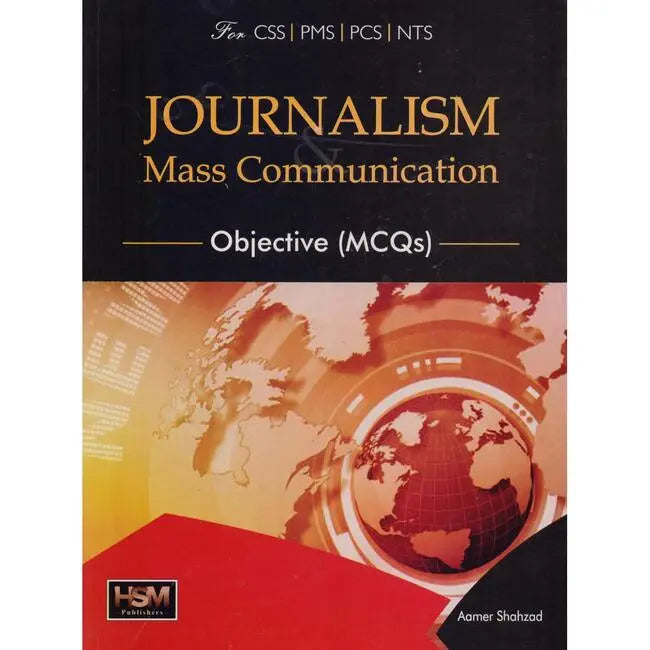CSS Journalism & Mass Communication 2025 Group 7
CSS Journalism & Mass Communication Syllabus 2025
This article covers the CSS Journalism & Mass Communication complete Syllabus.
The syllabus of CSS Journalism & Mass Communication consists of 8 parts of a collective 100 marks.
The examination for CSS Journalism & Mass Communication is the Group 7 exam for CSS candidates
CSS Journalism & Mass Communication Syllabus 2025
Paper (100 Marks)
-
Introduction to Mass Communication:
- Concept, Definitions, Need/Importance/Purposes, Types of Communication, Process of Communication, Basic Models.
- Functions of a model, Evaluation of a model
- Basic models in Mass Communication: a) Lasswell’s Model (1948) b) Shannon-Weaver model (1948) c) Osgood,s model (1954) d) Schramm’s model (1954) e) Newcomb’s symmetry theory (1953) f) Westley-McLean’s model (1976) g) Gerbner model (1956)
-
Mass Communication Theories:
- Normative theories of the press: Schramm’s four theories and criticism on these theories
- Media as agents of power
- The Spiral of silence
- Media Usage and gratifications
- Media hegemony
- Diffusion of innovations
- Powerful effects model: hypodermic needle, magic bullet theory.
- Moderate effects model: two-step and multi-step flow of communication.
- Powerful media revisited: Marshall McLuhan’s media determinism
-
Global / International Communication:
- The Historical Context of International Communication
- Globalization, technology and the mass media
- Communication and Cultural imperialism
- Communication Flow in Global Media: Imbalance in the flow of Information between North and South
- McBride commission and its recommendations.
- International Communication in the Internet Age: the new social media and its effects on the developing world
-
Media and Society:
-
- Mass media and social change
- Media as a social system: The balance between interrelation and interdependence
- Media freedom and its role for democracy,
- The functional approach to mass media: four social functions of the media
- Media as an awareness agent
- Mass media and social representation
-
Mass Media in Pakistan:
- Media system in Pakistan: historical, chronological and analytical review
- The system of journalism and the media system
- Employer-employee relations in Pakistani media
- Government-press relations
- Press in Pakistan: The newspaper industry, from mission to the market
- Electronic media: from total dependence to enormous power
- The new 24/7 television: uses and abuses
- The new radio: potential for change and the present performance.
- The question of freedom and responsibility
-
Development Support Communication:
- Theories of development support communication with a specific focus on the Developing World
- The dominant paradigm of development: historical, analytical perspective
- The Alternative paradigm of development
- Small is beautiful: community development as a snowball effect.
- Globalization vs Localization
- Glocalization
- Social Marketing: how to infuse new ideas into a developing population
-
Public Relations:
- Concept of Public Relations
- Historical development of public relations: from press agentry to PR
- Public relations in Pakistan
- Ministry of information
- Press Information Department (PID)
- Public relations and publicity
- PR as a tool for governance
- Private PR agencies and their structure
- Basic methods of PR: press release, press note, press conference
- PR Ethics
-
Media Laws and Ethics:
- History of Media Laws in Pakistan
- Development of media regulations from British colonial era to Independent Pakistan
- Libel, Defamation and relevant portions of PPC
- PPO, RPPPO
- PEMRA: establishment, development, and operational mechanisms
- Press Council of Pakistan (PCP)
- Citizens Media Commission: need, present status, and reasons for inactivity
- Press Code of Ethics
- The inability of the media to develop a code of ethics as an institution
- The media’s quest for freedom and its inability to self-regulate
This is the complete syllabus for preparation of CSS Journalism & Mass Communication.
The Candidates should prepare thoroughly to succeed in the examination.
Therefore, here are a few suggested books you can buy for better learning about CSS Journalism & Mass Communication from your favorite Multan Kitab Ghar online bookstore.
Suggested Reading Books for CSS Journalism & Mass Communication Syllabus 2025
- Broadcast Regulations: the German Example by Metzger, Herbert. FES 1993.
- Communication Models for The Study of Mass Communication, 2 nd Ed by McQuail, Dennis &Windhal, Swen, Longman, 1982.
- Convergence Culture: Where old and new Media by Blackwell publishing Ltd, USA.
- Communication Theories: Origins, Methods and Uses in the Mass Media 5 th Ed by Werner J. Severin, James W. Tankard Jr. Longman, 1997.
- Diffusion of Innovations 5 th Ed by Rogers, Everett M. Free Press 2003
- Ethics in Journalism: A Reader on Their Perception in the Third World by Kunczik, Michael (Ed.). FES 1999.
- Handbook of International and Intercultural Communication 2 nd Ed by Gudykunst & Mody, Sage, 2001.
- McQuail's Mass Communication Theory, 4th Ed by Denis McQuail. Sage, 2000.
- Media And Society into the 21st Century: AHistorical Introduction by Blackwell publishing Ltd, USA.
- “Media / Impact” by WadsWorth/ Thompson Learning, Belmont, CA


